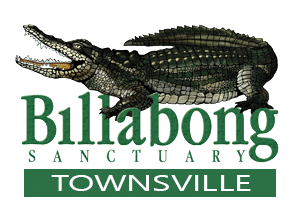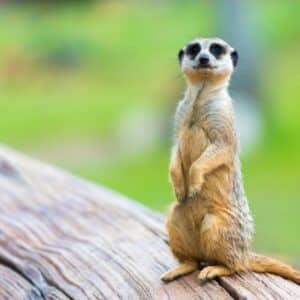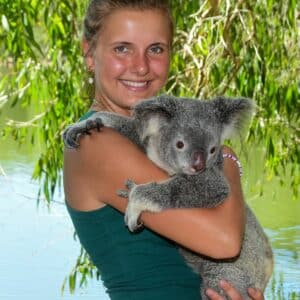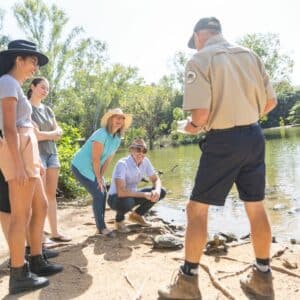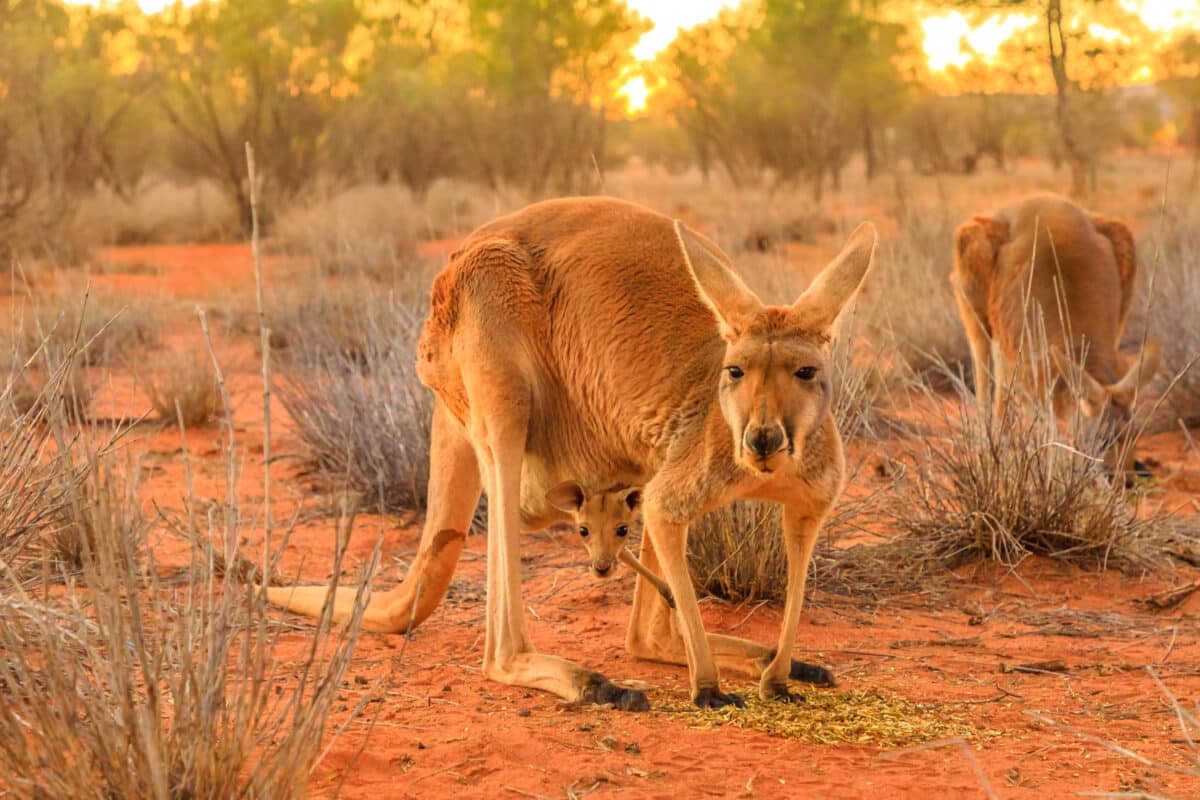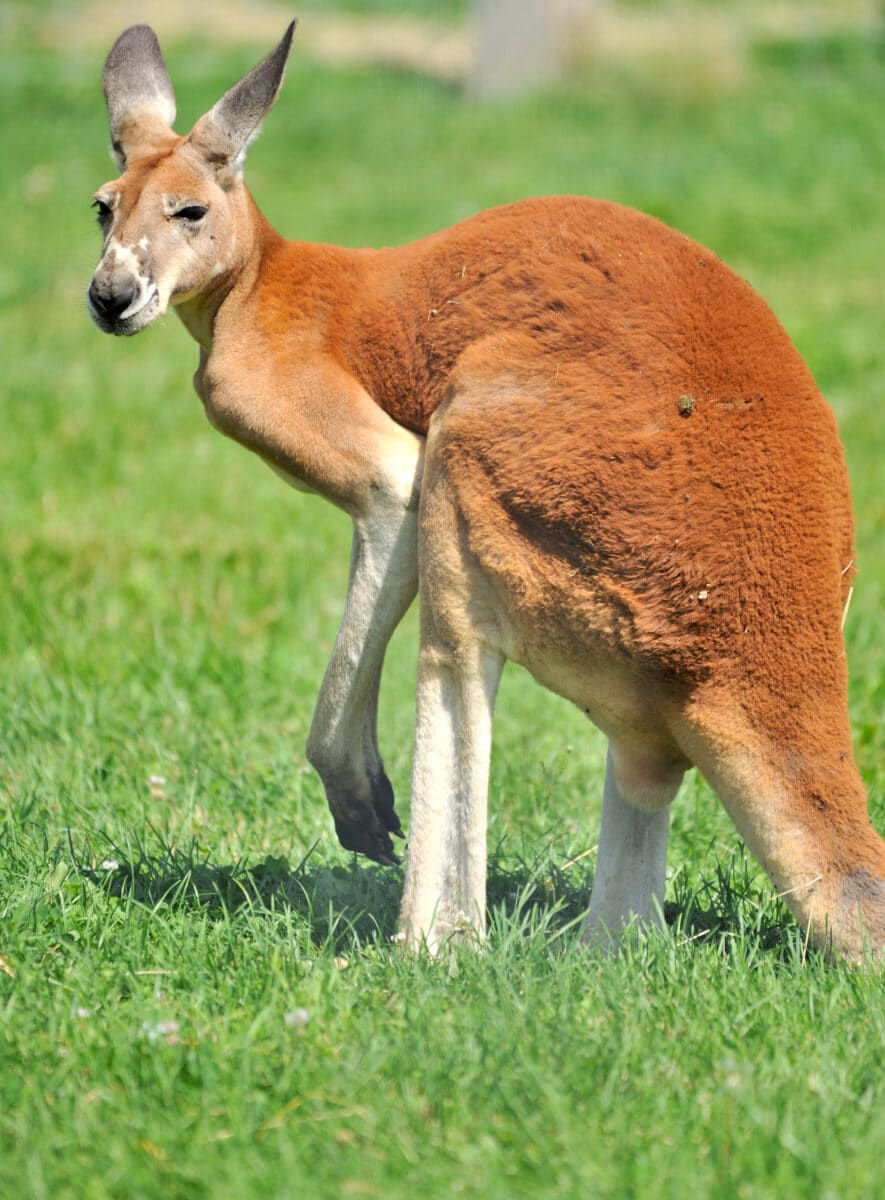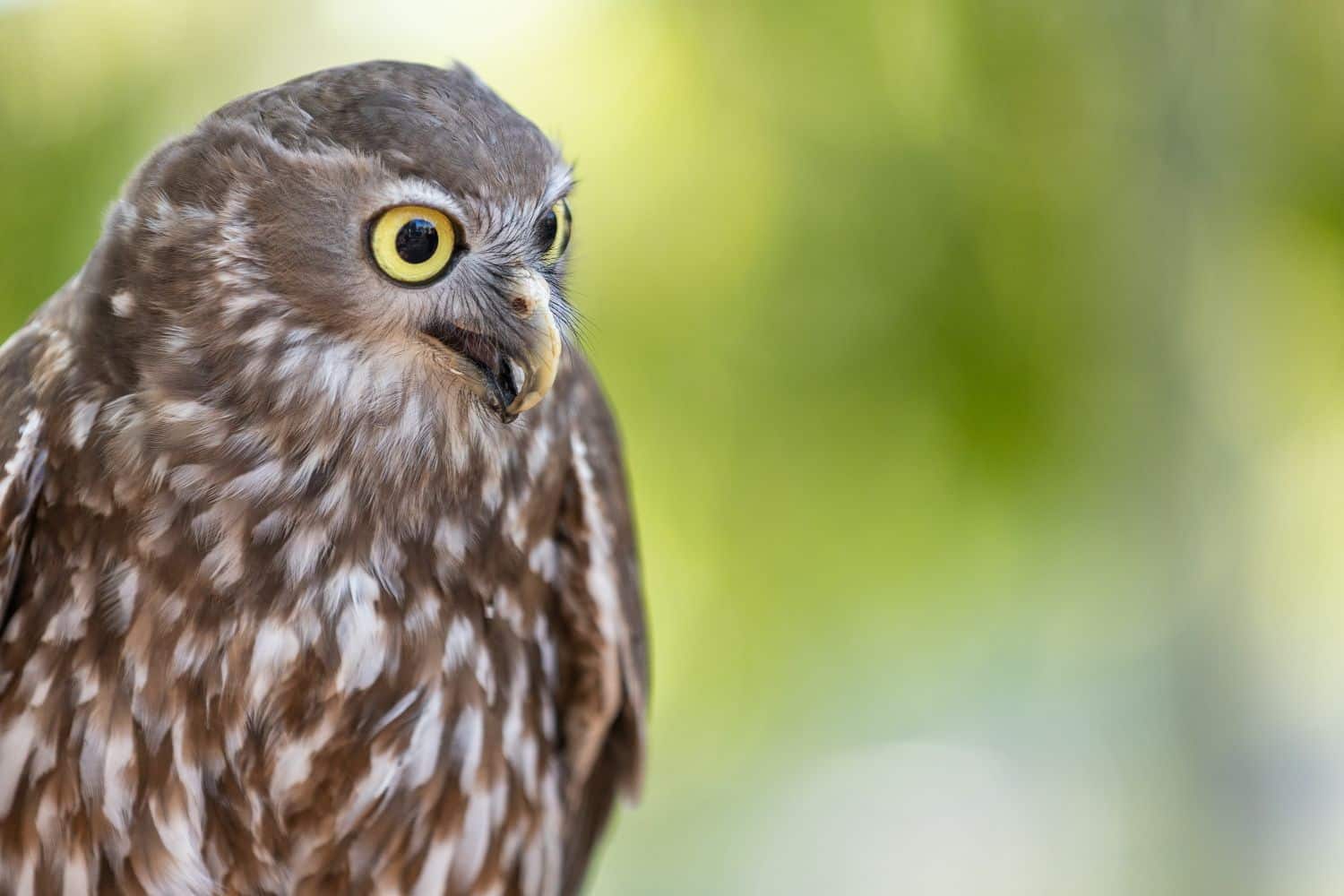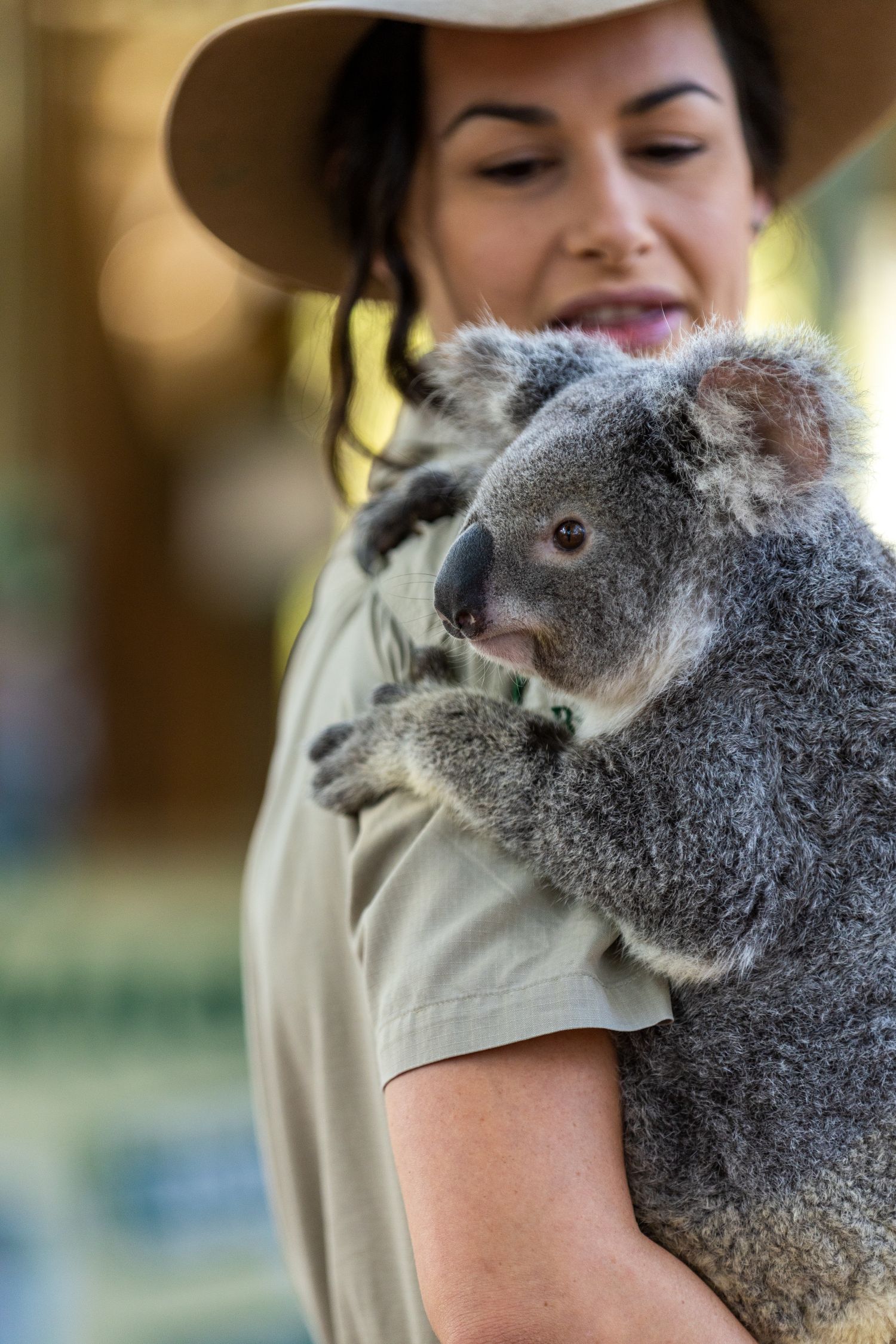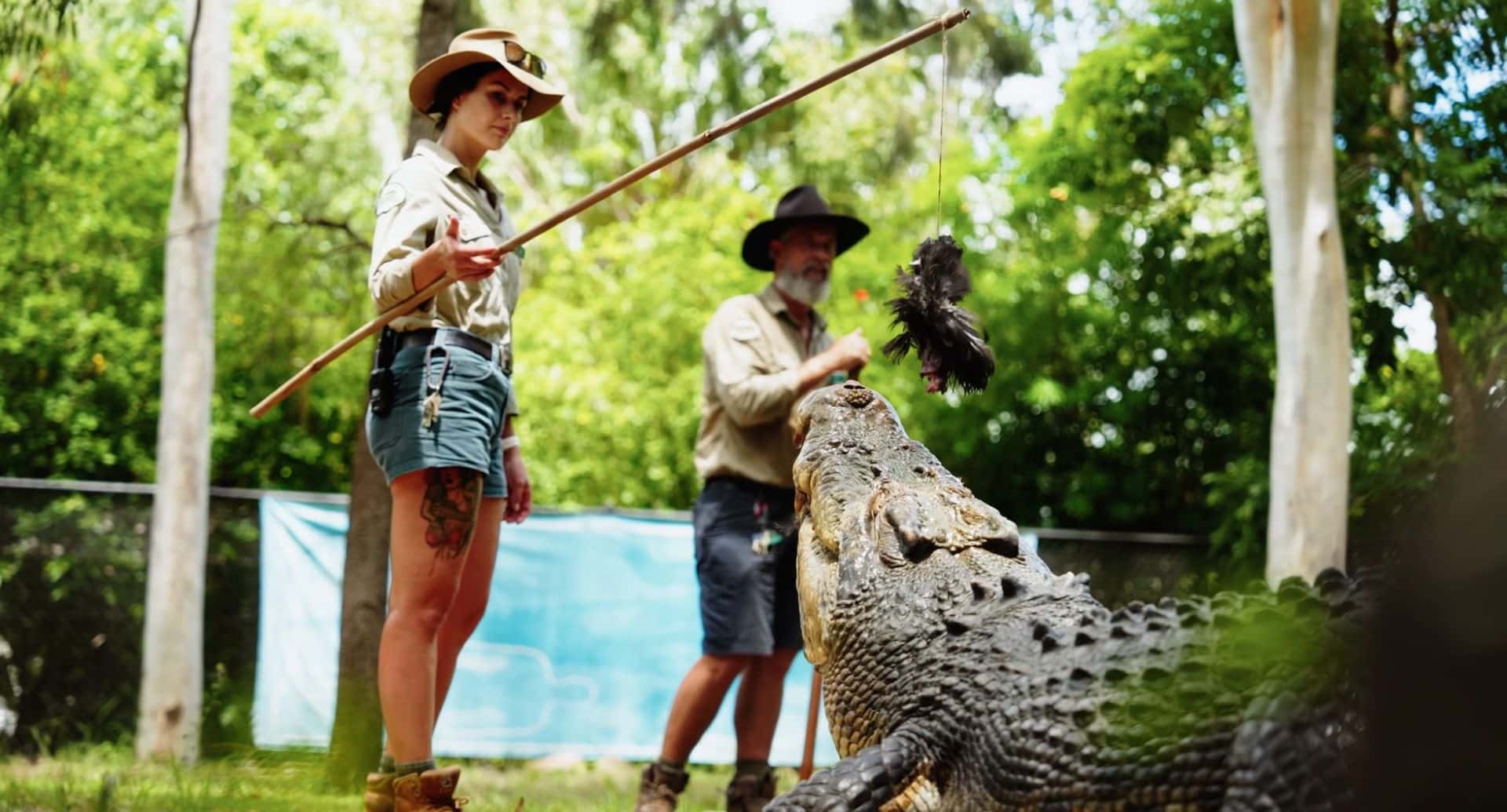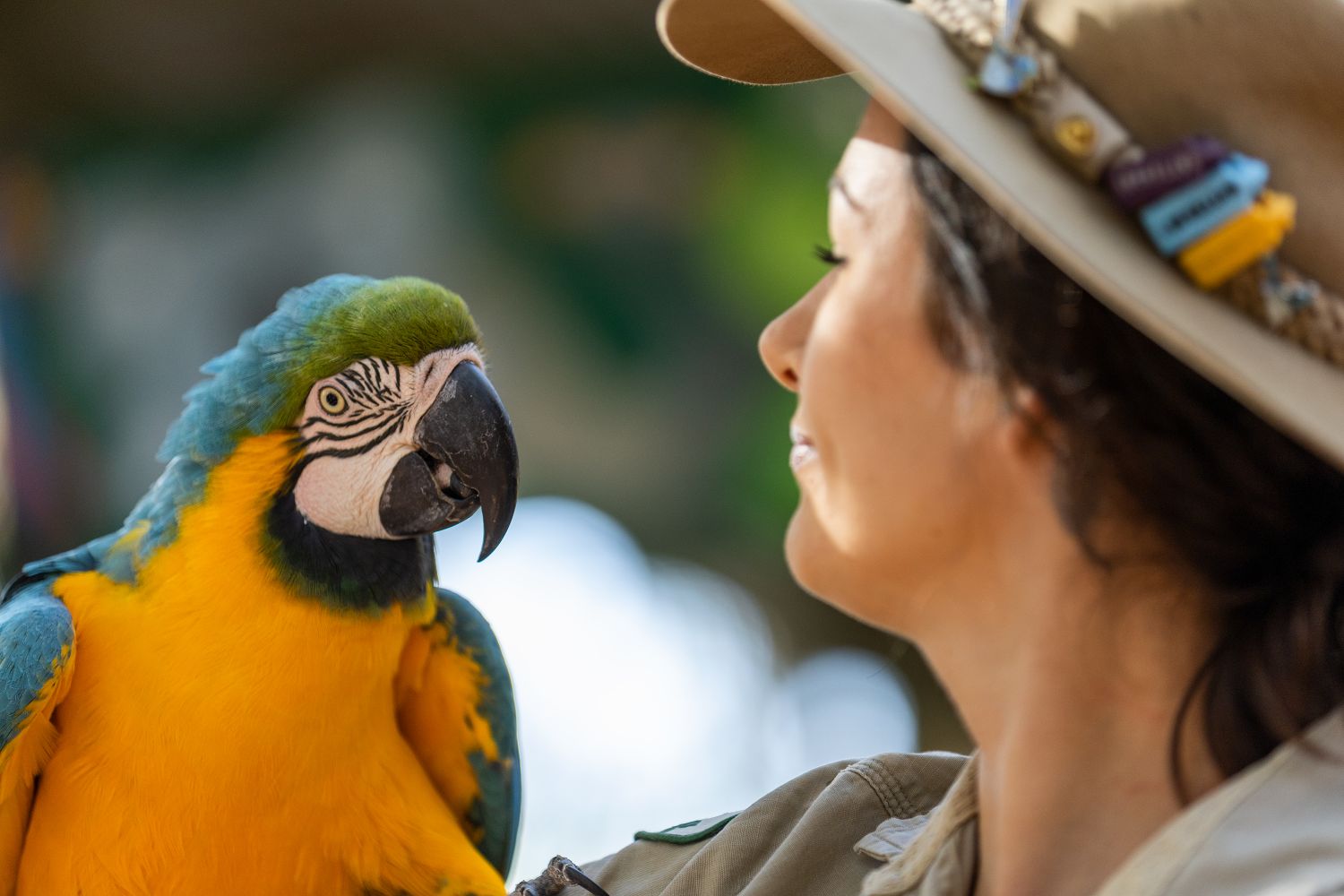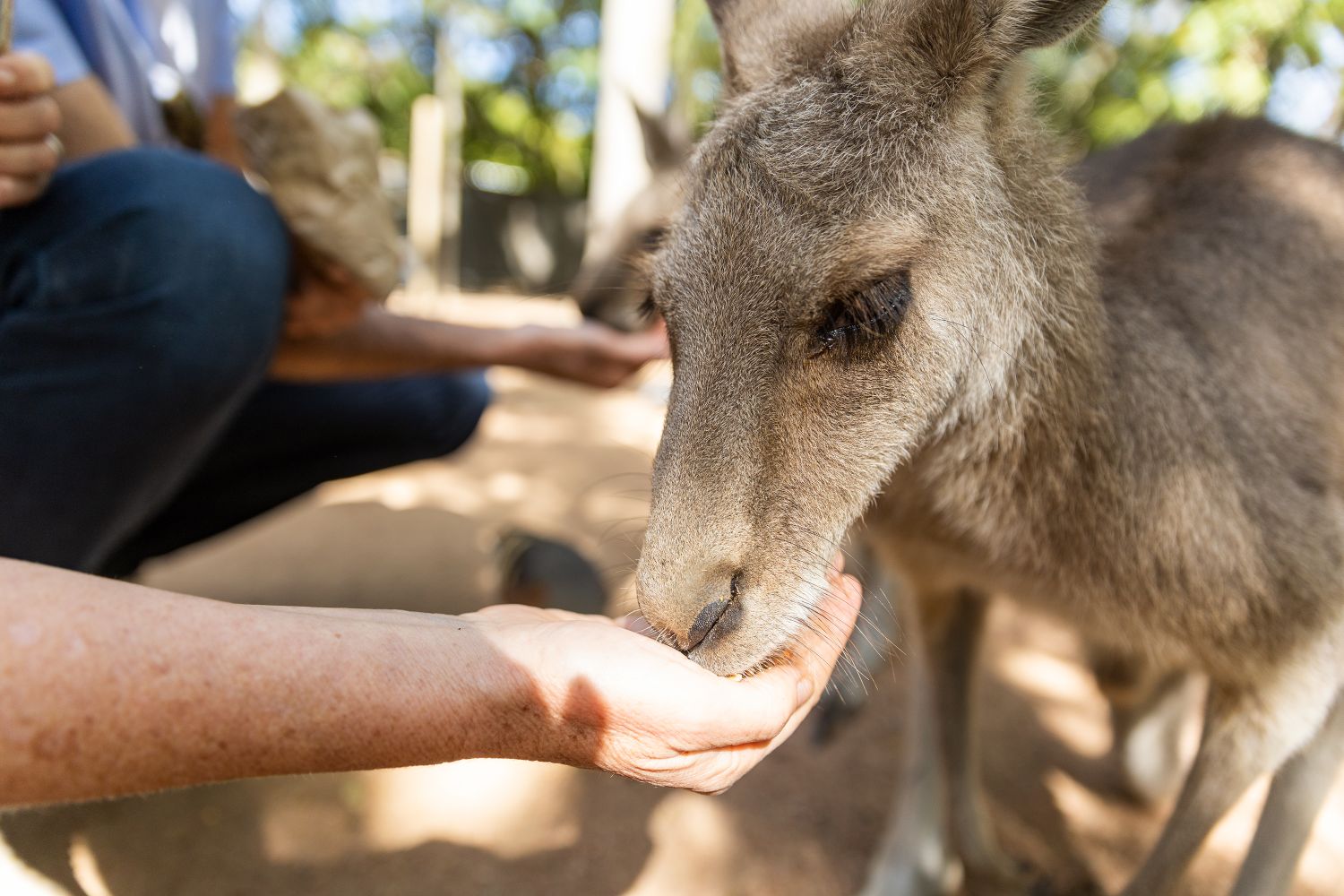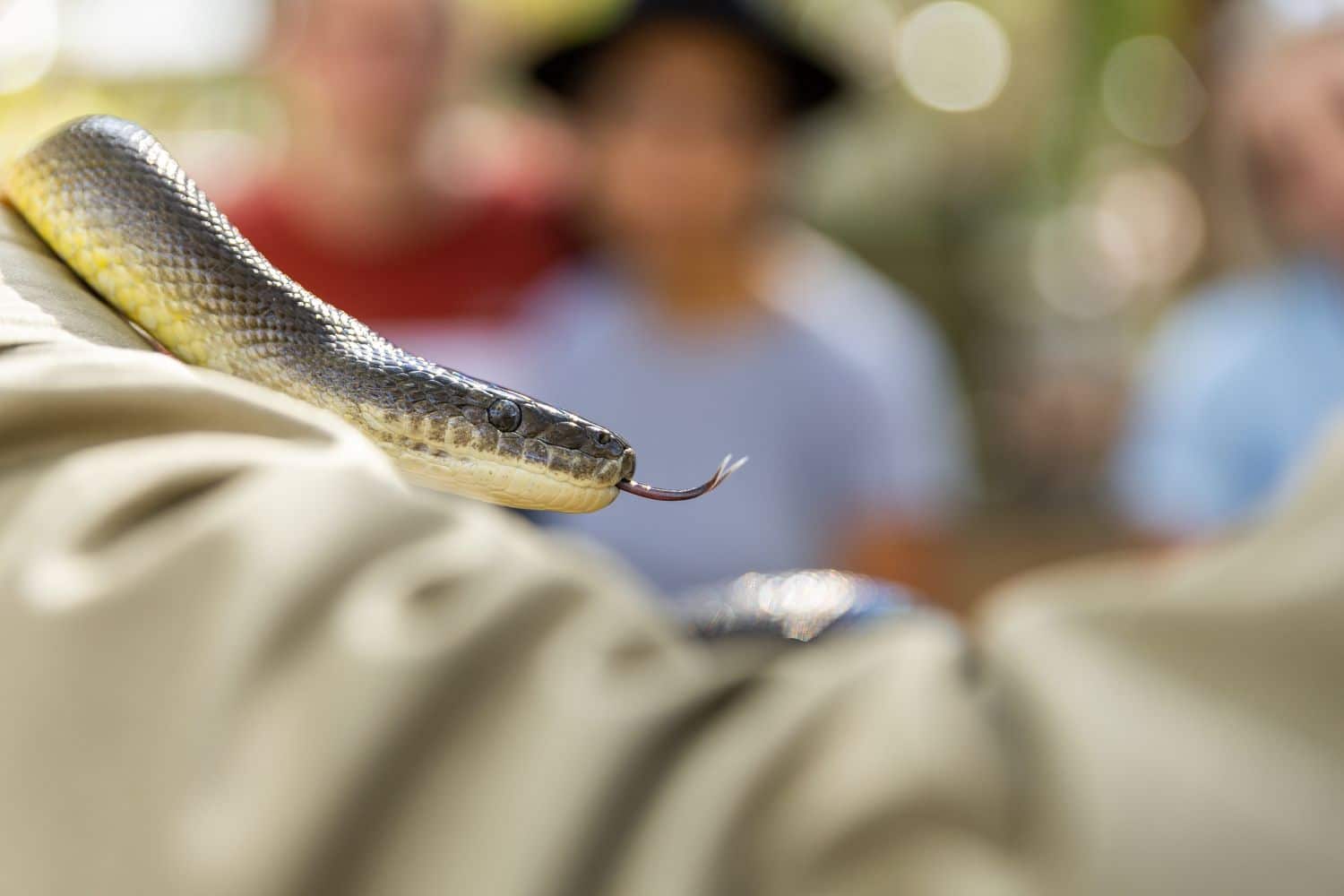Our national emblem is used to identify anything from airlines to our Olympic basketball teams.
Yet surprisingly few people ever see a mob of red kangaroos in the wild. They live in the dusty interior, far from the major cities.
Here at Billabong Sanctuary, we have our own ‘boomers’ in residence. Grab a bagful of seed from the kiosk, and then head over to Macropod Corral. You could soon have one of these gentle giants eating out of your hand.
WHAT DO THEY LOOK LIKE?
Kangaroos belong to the mammal family Macropodidae (meaning ‘big feet’). Members of this group range from tiny hare-wallabies to typical wallabies and wallaroos and the largest of all – the grey and the red kangaroos.
All have a characteristic pear-shaped body with a relatively small head, enormous back legs, shortened front legs, and powerful tails. There are five well-developed toes on the front feet; there is no opposable digit, but the front paws are very much like hands, and are used for holding food.
The back feet have four toes, but the inner two are fused up to the claws. (This feature is called ‘syndactyly’.) The double claw at the end is used for grooming. The central claw on the hind foot is long and powerful and is used as a weapon in aggressive and defensive attacks.
Red kangaroos have soft red to greyish fur and are the only members of this group to have white fur on their underparts. There is a black and white patch at the side of the muzzle, and a white stripe from the corner of the mouth to the base of the ear.
The females are often bluish-grey in colour, so have been given the nickname ‘blue fliers’.
Large males are also called ‘boomers’.
Red kangaroos are the largest of Australia’s marsupials. (A marsupial is a pouched mammal.) An adult male stands over 1.8m tall (5 ft 10 in) and can weigh up to 90kg (198 lb). He can tower over a tall person! Total length of the head and body averages about 1150mm (3.8 ft) with an average tail length of about 880mm (2.9 ft.) Females are much smaller, with an average weight of about 26.5kg (58 lb).
WHERE DO THEY LIVE?
Red kangaroos live throughout most of the central part of mainland Australia, in areas with less than 500 mm (18 in) average annual rainfall.
They prefer open plains habitat, including grasslands and deserts, as long as there are at least a few scattered trees for shelter.
A group of kangaroos (called a mob) may consist of from two to several hundred animals. There is usually one dominant male, several adult females, and both male and female juveniles.
Mobs of kangaroos travel long distances and easily get past artificial barriers such as stock fences.
COPING WITH THE HEAT
Summers in the interior of Australia are intensely hot; daytime temperatures often reach well over 40 C (105 F). Kangaroos rest under trees or shrubs during the heat of the day and come out to feed in the cool of the evening and at night.
Kangaroos can’t sweat when they are hot, as people can. Instead, they lick their chests and the insides of their forearms till the skin is quite soggy. The blood vessels in these areas are close to the surface of the skin. When the moisture evaporates, it cools the blood circulating underneath, which helps to cool down the whole animal.
This evaporative cooling is the same principle as that used in air conditioners!
Kangaroos have long, thick eyelashes that help to protect their eyes from the glare of the sun.
POETRY IN MOTION
When travelling fast, the kangaroo bounds forward on its huge, powerful hind legs, with the tail held out behind for balance, and the front legs tucked in close to the body. This motion is very fluid and graceful, and the roo can cover huge distances, with leaps up to 8m long (26 ft), and short bursts of speed reaching nearly 65kph (40 mph)! An average travelling speed would be about 12kph (8 mph).
When kangaroos are moving slowly, or feeding, they balance on their small front legs and tail, swing their hind legs forward like a pendulum, then bring up the tail and front legs to complete the movement. The muscles of the hind legs are attached in such a way that when travelling on land, the kangaroo always moves both limbs together. Interestingly, if the kangaroo ever has occasion to swim, it can then move its hind legs separately.
With these strong hind limbs, the kangaroo can jump vertically from a standing start over obstacles as tall as itself. Females with a large joey in the pouch can bound at top speed up a near vertical slope.
Male kangaroos also use their tail to balance when they rise up on their hind legs and have ‘boxing matches’ with other males. They tip back their heads and swat at each other with their long front claws, or kick out with their strong back legs, armed with that powerful central claw. When one male backs down, the other will stop attacking. They may then casually scratch themselves, and resume feeding.
WHAT DO THEY EAT?
Red kangaroos eat green grass and herbage, feeding mainly at night. They can live for long periods without water, utilising the moisture in their food.
ADAPTATIONS FOR THIS DIET
This diet is high in cellulose. In common with other animals, kangaroos lack digestive enzymes to break down cellulose, so they have evolved both mechanical and chemical means of extracting nourishment from their food.
Grass is nipped off with the front teeth (incisors) which grind against a hard plate at the top of the mouth. There is a gap (called a diastema) between the front teeth and the back teeth (molars). This gives the tongue more room to push the food about inside the mouth and to position it between the molars for grinding.
The molars have sharp grinding surfaces. As the animal grows, the molars erupt in succession, with the one in front dropping out, and the ones behind moving forward to take its place. This way there is always a sharp new cutting surface to break down the plant matter.
The stomach is divided into two parts: the sacciform and the tubiform. In the front part, shaped like a large sack, are millions of microscopic organisms, mainly bacteria but also fungi and protozoa. These microbes ferment the plant matter, releasing nutrients that the Kangaroo can use.
Food may stay in this forestomach for up to 16 hours while fermentation takes place. The kangaroo sometimes coughs up an undigested bit of food and chews it some more before re-swallowing it. This is similar to a cow chewing its cud.
Once fermentation is well underway, the partially digested food passes into the second, tube-shaped part of the stomach, where acids and enzymes secreted by the Kangaroo complete the process of digestion.
BREEDING AND BIRTH OF THE YOUNG
The reproductive biology of the kangaroo is unusual and amazing, for several reasons.
The most well-known, of course, is that most of the development of the young takes place not in the womb, but in an external pouch.
The female is often nurturing young at three entirely different stages of development, even producing milk of different composition in different teats.
In addition, development of the youngest embryo can be turned on or off, depending on external conditions.
HERE IS THE STORY:
The female red kangaroo may come into season at any time of the year. To check if she is ready for breeding, males will approach and sniff the area around the base of her tail. They may also smell her urine.
If the female is nearing the stage when she will be receptive to breeding, the male will start to follow her closely, sometimes grasping and stroking her tail. The dominant male of the mob will eventually be allowed to breed, with mating lasting 10 to 15 minutes.
The young are born 33 days after mating. To get ready for the birth of the joey, the female will lick the pouch clean, and lean up against the base of a tree, resting on her hindquarters with her tail passed between her hind legs.
The baby kangaroo is hairless and tiny, barely the size of a peanut, and weighing less than a gram (< 0.03 oz). Nevertheless, it leaves the birth canal and makes its way into the pouch unassisted by the mother. This journey takes about 15 minutes – an amazing task for such a minute, sightless creature, using only rudimentary forelimbs to claw its way upwards.
Once inside the pouch, the miniature joey attaches itself to one of the four teats. It will suckle exclusively from this one teat until it is weaned.
A day or two later, the female will breed again, but the embryo resulting from this second pairing will remain dormant inside her body until the first joey has left the pouch. Once the pouch has been vacated, or if the joey in the pouch dies, the dormant embryo will start to develop to replace it. This remarkable feature of Kangaroo reproduction is called embryonic diapause.
RAISING THE YOUNG
While the very young joey is developing inside her pouch, the mother will continue to lick the pouch clean, and will consume the joey’s waste products.
The joey remains attached to the teat for 120 to 130 days, during which time its body remains pink and naked, and its eyes are closed.
At about 100 days the joey starts to move its limbs inside the pouch. By about 150 days its eyes have opened and it peeks out of the pouch for the first time.
Growth over the next 40 days or so is rapid; the limbs start to develop and often stick out of the pouch. The mother starts to groom the joey, and it starts to sniff at her head and at its surroundings. As she leans close to the ground to feed, it can lean out of the pouch to take its first taste of grass or other plants.
By about 190 days, the joey weighs about 2kg (4.5 lb) and will emerge from the pouch for the first time, usually by toppling out. At first it will remain in the open air for only a minute or two, then quickly scramble back into the safety of the pouch.
To climb back into the pouch, it kicks with its hind legs and does a complete somersault, ending up with it head facing the opening. The mother can control the joey’s exit and entrance from the pouch by relaxing or contracting the muscles around the opening.
For the next few weeks the joey will start to make progressively longer excursions away from the mother, returning quickly to be groomed or to suckle.
By the time it has reached about 4.5kg in weight (10 lb) the joey no longer climbs back into the pouch. It remains close to its mother, continuing to suckle by sticking its head into the pouch for the next four months or so.
Meanwhile, the dormant embryo has developed, and a second newborn joey has entered the pouch and attached itself to one of the other teats. At this stage the mother actually produces two different types of milk! The milk in the teat used by the newborn joey is much lower in fat than the milk in the teat used by the joey at heel.
She will also mate again, once the newborn joey is in the pouch, so that she will actually have three offspring, at different stages of development.
The young joey at heel is weaned at about one year of age. Even when the mother no longer allows it to suckle, it often remains in close association with her till it reaches sexual maturity.
Male red kangaroos mature at about two years of age, and females when they are from 15 to 20 months old.
Red kangaroos can live for up to 20 years in the wild.
STATUS IN THE WILD
There are millions of red kangaroos in Australia, and their status is secure.
In fact, because of their perceived status as pests to graziers and farmers, hundreds of thousands of kangaroos are legally culled every year in New South Wales, Queensland, South Australia and Western Australia.
Problems apparently caused by red kangaroos are listed by graziers and farmers as competition with livestock for food and water, and damage to fences and crops.
The kangaroo cull is undertaken by licensed shooters, following strict guidelines, on a quota basis. Quotas are set every year based on aerial surveys of the Kangaroo population.
In 2002, the red kangaroo quota for Queensland is a little more than 1 million animals. This represents about 10% of the total population, so that the estimated number of red kangaroos in Queensland is more than 10 million. The quota for the whole country is set at just over 2 1/2 million.
Hides and/or meat are harvested and sold after the animal is shot.
Quotas are rarely met in any given year. For example, in 2000, the most recent year for which figures are available, less than half the allotted number of red kangaroos were actually shot.
There are few non-human predators on red kangaroos. Dingoes are probably the most significant, while foxes and wedge-tailed eagles can take young animals.
Because red kangaroos are closely monitored and managed by wildlife officials, and because of their value as our national symbol, as well as the economic value of their hides and meat, it is unlikely that they will ever become endangered.
Generations to come will have the opportunity to enjoy the stirring sight of a mob of red kangaroos bounding effortlessly over the open plain.
